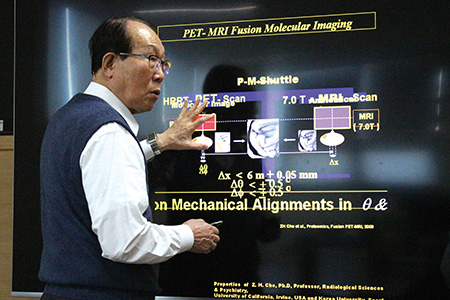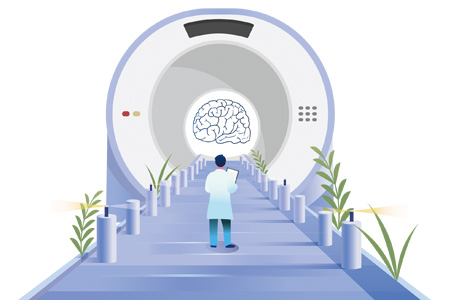Experiencing the reputation of “Science KU”
Professor Cho took out his mobile phone to show a photo that represented the culmination of one of his long-held dreams. The photo featured the new building of the College of Engineering at night. Almost all the laboratory lights are on, like the stars in the heavens. Professor Cho appreciates KU’s scientists, who are devoted to their study even at night. Although only one season has passed since he joined Korea University, he is experiencing the reputation of “Science KU.” The fact that he himself took the picture means that he was also there in his laboratory at that moment in the dead of night. For Professor Cho, happiness comes from focusing on research no matter what happens in the world. It is happiness that neither money nor fame can bring.

“I came to Korea University with a joyful heart, because Professor Lee Hai-gun (Department of Materials Science and Engineering), with whom I worked in MRI research, proposed that we conduct a new study together. The core component of MRI is a magnet, which is usually prepared by using liquid helium and liquid nitrogen. What Professor Lee is developing is a method to prepare the magnet without liquid helium. We will work together in this Brain Science Convergence Center. It is very exciting.”
Professor Cho has devoted his entire life to research, and his scholarly journey is never-ending. He continuously encounters problems to solve and goals to accomplish. These do not tire him; on the contrary, they energize him. He spent the last decade developing a 7T MRI. He has now doubled his goal and is attempting to develop the world’s first 14T MRI.

His single path opened a new way after half a century
Professor Cho stands out as the world’s only scientist in the world with development experience in CT, PET, and MRI, the Big Three apparatuses for modern human body imaging. He joined in the development of CT, which was introduced in 1972. Only three years later, he developed the world’s first PET in 1975. In 1985, he became the first person to develop and provide MRI in Korea. Thanks to him, we are living in a world where we can look into our brain as simply as we can view the lines on our palm. However, Professor Cho’s scientific developments did not end with the MRI. In 2007, he developed the world’s first PET-MRI convergent diagnostic apparatus. Fully aware of the advantages of PET and MRI, he boldly attempted to combine the two.
With his bold inventions, Professor Cho came to be known as the scholar closest to the Nobel Prize among Koreans. At this moniker, however, he shakes his head, explaining it in terms of probability. “There are 5,000 regular members in the National Academies. Most of them expect in October each year that they themselves may be the winners of the Nobel Prizes. Because I know the low probability, I have never anticipated the Prize. However, I acknowledge that the devices that I developed have had a positive effect on this aging society. The devices enable us to discern whether we have Alzheimer's disease or Parkinson’s disease or we only have similar, temporary symptoms. If we have a disease, we can receive treatment; and if we do not have a disease, we can take preventive measures. It is more joyful to me that I have a share in someone’s healthy life than winning a big prize or being honored by others.”
Professor Cho is a so-called cosmopolitan. Born in Yeonbaek-gu, Hwanghae-do, he grew up in Seoul and attended Seoul National University’s College of Engineering. In 1962, just before finishing graduate school, he went to Uppsala University, Sweden, for a short-term training for one year. Thanks to the help from his advisor, who noticed his abilities, he completed his doctoral course there. He then proceeded to a post-doctoral course at Stockholm University, later moving to the US as an associate professor at UCLA in 1972. From that time, he has enjoyed continual success. At the age of 43, he became a full professor at prestigious Columbia University, and became a regular member of the National Academies of Sciences, Engineering, and Medicine, the association of the world’s prominent scholars, at the age of 61.

While at Columbia University, he also worked as a professor in KAIST, Korea, with continual research in the US and Korea for two decades. In 2004, he returned to Korea when he was appointed as the chief of the Neuroscience Research Institute at Gachon University. As a pioneer in science and technology in Korea, Professor Cho willingly uses the knowledge that he gained outside Korea for the development of science and technology in his home country.
Drawing Water of Philosophy from Well of Science
Professor Cho spoke of principles in life. “I learned from my life that those who seek honesty, rather than immediate gains, laugh last. The same is true in brain science. The brain becomes red-hot when you tell a lie, because your brain is wasting your energy. We are often tempted to employ an expedient, but we have to overcome the momentary temptation if we don’t want to spoil our life in return for a little profit. Honesty is essential in the academic world. A fake report is caught soon. When your study does not go well, you should honestly show it in the paper. That’s the way you can make progress.”
Another life principle that he appreciates as much as honesty is positivity. When a bad thing happens, he thinks something good may soon follow. Life goes through thousands of ups and down. We cannot be disappointed each time we encounter tough times. He learned from his experiences that opportunities come again and again. That’s why he emphasizes that it’s a profitable business to go to find a forest of hope instead of sinking down into a swamp of despair.
“My life now is not very different from the one that I lived 30 or 40 years ago. How happy it is that I can focus on research my entire life! It’s not good to give up what you have done for a long time just because you are old or have retired from a job. I believe that the secret of aging well is to continuously do what you can do to the end.”
Professor Cho continues to live life in the fast lane, but he was, in fact, a daring boy in his youth. Immediately after the liberation of Korea, he used to go up to Mt. Namsan with his friends, and pick up the waste batteries used by the US soldiers. Much to his parents’ delight, he would use the waste batteries to light up old bulbs. When the US soldiers he became acquainted with gave him a new battery, he traded it in for parts to build a radio. Immersing himself in invention was fun for him. Later, during his university years, he fell in love with the mountains. He acknowledges that his experiences in the mountains, facing a rough cliff or climbing up to a steep peak, have positively affected his life. He is already in his mid-80s but his face reflects various ages in life. He has the playfulness of a small boy, the vigor of a young man, and the warmth of an old man, and with his gregarious nature, can be anyone’s friend.

Chair Professor Cho Zang-hee
Professor Cho graduated from the Department of Electronic Engineering at Seoul National University and received the master degree from the graduate school of the same university. He received the doctoral degree in applied physics in Uppsala University, Sweden. He worked as a professor at Stockholm University, UCLA, UCI, Columbia University and KAIST. In 1972, he developed a mathematical solution for CT. Later, he developed circular PET, 2T MRI and 7T MRI for the first time in the world. He is a regular member of the US National Academies, and considered as the scholar closest to the Nobel Prize among Koreans. After returning to Korea in 2004, he worked as an endowed-chair professor at the Neuroscience Research Institute Gachon University. He is now a distinguished professor at the Green Manufacturing Research Center, College of Engineering, Korea University.



